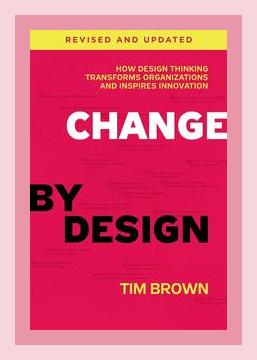Leadership and ManagementInnovation and CreativityInnovation LeadershipInnovation ManagementDesign ThinkingProduct DevelopmentIdea Generation
Summary: Change by Design by Tim Brown
Tim Brown’s “Change by Design,” published in 2009, is a comprehensive guide to the principles and practices of design thinking. The book emphasizes the importance of human-centered design in solving complex problems and fostering innovation across various domains. Divided into several interrelated parts, the book covers the basics of design thinking, its application in different contexts, and actionable steps for individuals and organizations.
1. Introduction to Design Thinking
Major Point: Design thinking is a human-centric approach to innovation that integrates the needs of people, the possibilities of technology, and the requirements for business success.
Concrete Example: Brown illustrates this with the redesign of an MRI machine to reduce the stress and fear experienced by children. Instead of focusing solely on the technology, the team prioritized the experience of young patients, resulting in a machine that is both functional and comforting.
Actionable Step: Always start by deeply understanding the end-users. Conduct interviews, shadow users, and immerse yourself in their daily lives to gain insights into their needs and challenges.
2. Inspiration: Becoming the Anthropologist
Major Point: Observation and empathy are foundational to design thinking. Designers should engage in immersive experiences to gain a first-hand understanding of user behavior and pain points.
Concrete Example: IDEO’s “KidTracker” project, where team members spent time observing families in their homes to design a wearable GPS device for children, emphasized the importance of ethnographic research.
Actionable Step: Dedicate time to observe users in their natural environment. Create empathy maps to capture your observations, highlighting emotions, behaviors, and pain points.
3. Ideation: Expanding the Horizons
Major Point: Ideation is about generating a wide array of ideas without immediate judgment. This phase values quantity over quality to spur creativity and uncover unconventional solutions.
Concrete Example: During a project to redesign the shopping cart, IDEO used rapid brainstorming sessions to generate hundreds of ideas before narrowing them down. They considered safety, efficiency, and user-friendliness in the design.
Actionable Step: Organize brainstorming sessions that encourage freewheeling and defer judgment. Use techniques like mind mapping, sketching, and role-playing to foster creativity.
4. Implementation: Prototyping and Experimentation
Major Point: Prototyping is an iterative process where concepts are quickly transformed into tangible models, allowing for immediate feedback and improvements.
Concrete Example: For a healthcare project, IDEO created rough prototypes of hospital gowns by cutting and sewing cloth themselves, gaining valuable feedback from nurses and patients before finalizing the design.
Actionable Step: Adopt a “fail fast, fail forward” mentality. Build simple prototypes using readily available materials and test them early and often with real users. Iterate based on the feedback you receive.
5. Design Thinking in Business
Major Point: Design thinking should permeate business strategy and operations to foster a culture of continuous innovation and user-centric solutions.
Concrete Example: Procter & Gamble’s “Clay Street Project” involved cross-functional teams working in a creative space to generate new product ideas. This approach led to the development of successful products like Swiffer and Mr. Clean Magic Eraser.
Actionable Step: Integrate design thinking into your organization’s culture by establishing innovation labs or dedicated spaces that encourage collaboration and experimentation.
6. The Role of Leadership in Design Thinking
Major Point: Leaders play a crucial role in championing design thinking, providing the vision, resources, and support necessary for innovation to flourish.
Concrete Example: At Steelcase, leadership supported a design-driven growth strategy by assembling diverse teams and investing in creative workspaces. This commitment helped Steelcase maintain its competitive edge in the office furniture market.
Actionable Step: Leaders should be role models for design thinking. They should prioritize empathy, foster creativity, and support risk-taking by providing resources and celebrating innovative efforts.
7. Crossing Boundaries: Collaboration and Diversity
Major Point: Diverse, cross-functional teams drive creativity and innovation by bringing together varied perspectives and expertise.
Concrete Example: IDEO’s collaboration with Mayo Clinic brought together designers, doctors, and patients to redesign the patient experience. This multidisciplinary approach resulted in significant improvements in patient care and satisfaction.
Actionable Step: Form diverse project teams that include members from different departments, industries, and backgrounds. Encourage open communication and the sharing of different viewpoints.
8. Design Thinking for Social Innovation
Major Point: Design thinking can address some of society’s most pressing challenges by creating solutions that are both innovative and human-centered.
Concrete Example: IDEO’s project in Africa helped improve the design of microfinance loans by closely observing how farmers interacted with financial products. This work led to more effective and user-friendly loan offerings.
Actionable Step: Identify social issues or underserved communities where design thinking can make an impact. Engage with these communities to understand their needs and collaborate on potential solutions.
9. Design Thinking for Personal Growth
Major Point: Individuals can also apply design thinking principles to their personal and professional lives to drive growth and achieve greater fulfillment.
Concrete Example: Professionals at IDEO apply design thinking to their career development by regularly re-evaluating their goals, skills, and satisfaction, ensuring they stay aligned with their passions and strengths.
Actionable Step: Use design thinking for personal development by mapping your career journey, brainstorming possible future roles, prototyping new skills through courses or side projects, and seeking feedback consistently.
Conclusion
Tim Brown’s “Change by Design” emphasizes that design thinking is not confined to designers but is a valuable methodology for anyone looking to innovate. By focusing on empathy, collaboration, and rapid prototyping, design thinking can transform products, services, and even entire organizations. To harness its potential, we must adopt a mindset of curiosity, embrace failure as part of the learning process, and always strive to deeply understand the people for whom we are designing.
By applying the principles and actionable steps outlined above, readers can begin incorporating design thinking into their own projects and organizations, driving meaningful innovation and lasting impact.
Leadership and ManagementInnovation and CreativityInnovation LeadershipInnovation ManagementDesign ThinkingProduct DevelopmentIdea Generation
